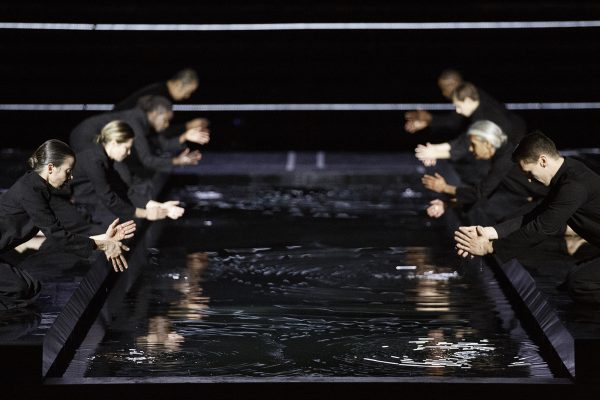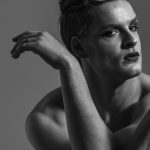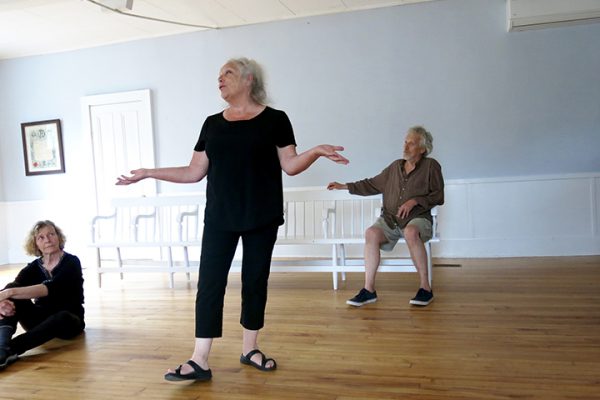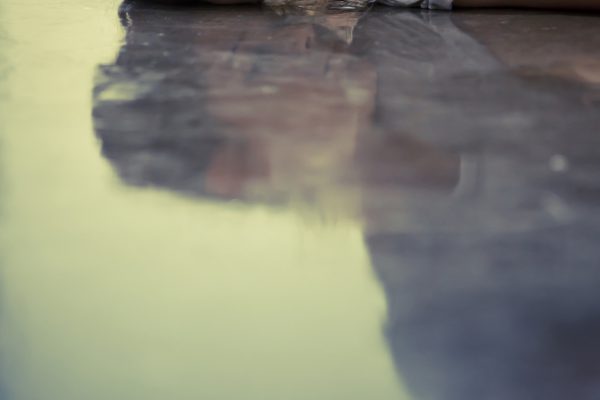Just a few minutes in, I actually felt dizzy watching Ron Stewart in “WhaT,?”, a full-length solo in which he careens about the stage in an endless stream of giddiness choreographed by Jennifer Mascall, a Vancouver Body-Mind Centering practitioner who has been making dance since the seventies. Stewart, a tall man in his forties, bent low and swished and swayed around the Firehall Arts Centre stage as if he had no backbone to hold him up. His rush of movement was so unbridled it appeared glib, even thoughtless — almost like the gibberish he spoke once during the hour-long work.
There was some method to the madness: the solo was divided into four parts in which Stewart flirts with a variety of characters and narratives, some apparently based on autobiographical memories of his own father. These are delivered through bits of storytelling as well as through that fearful compulsion to move, which left Stewart breathing so hard that he sometimes lacked the breath to support his voice. This made the storytelling, which is pretty constant throughout, hard to follow.
“WhaT,?” opens with an evocative line drawing of a tall cowboy by animator Jordan Bent that forms on a large screen upstage right (for other scenes, the drawings are of a man’s face and an old boot with flowers). Stewart, dressed up in a black cowboy hat, tight white pants, patterned shirt and runners, appears in the gloom: Bent’s drawing come to life. A country and western tune begins, part of a sound score by one of the evening’s four composers/sound designers: Douglas Macaulay, Stefan Smulovitz, Greg Senko and Ian Cook (presumably one for each part but this is not specified in the program). Stewart’s long spidery movement is punctuated with a series of funny-peculiar moves — arms or knees flapping, or falling to the floor over and over in melodramatic ecstasy. The latter illustrates his story about falling in love, which involves a woman who cornered him in a booth in a diner and a voluptuous lady in a limo.
Each scenario ends when Stewart changes into one of the outfits laid out on the four green mats placed in a row across the front of the stage. For the second scenario, his arms wildly trembling, he puts on a long-sleeved T-shirt, sits on the floor and ties up his boots with his legs stretched out straight in front of him — a position that makes the laces hard to reach; he tops off his ensemble with a red beret. Stewart reads from letters he carries around with him, staggering about on his toes, until he inexplicably switches gears and sprawls comfortably, quite relaxed, on the floor. He mentions something about Normandy, 1944, and partying to the sound of distant bombs, and reads from a love letter that ends with a series of lover’s Xs. By this time, Stewart has walked off-stage and thrown himself flat against a wall near the exit, and he shouts those intimate loving Xs out loud — not with emotion, just very, very loud — before launching into a story about a conversation between Hitler and Mussolini.
Then comes the kind of quirky shenanigans for which modern dance is either loved or hated: the dancer strips off all his clothes and drinks from a water bottle before dousing himself with what’s left. In effect, he grabs a quick shower. Well, yes, dancers do get hot and sweaty when they dance — but they usually wait till after to wash. What’s the point mid-show? Sure enough, within seconds of dressing — this time in a straw hat and black vest — Stewart again drips with sweat.
This third scenario is set in a disco with pounding music, followed by the final episode, during which Stewart sports a diamond-patterned vest and plaid tam-o’-shanter, signifying his Scottish grandfather, and pajama bottoms to evoke — I’m guessing here, as it’s not stated outright — his dad, who appears to live in a seniors’ residence. There are several amusing moments, as when Stewart mimes helping his dad up from his chair and has to bend over to support him as they walk together. “Can you do me a favour,” Stewart quietly asks, “and walk a little straighter?”
According to the program note, “Stewart exemplifies the connections between fathers and sons,” but there was too little specific heart behind the project to add up to anything so concrete. It didn’t help that “WhaT,?” was presented on a double bill, following Julia Mackey’s one-woman “Jake’s Gift”, a play that oozes heart.
Mackey’s play was also much more directly about war (presumably it was the subject matter that led the two works to be presented together, and to open on Remembrance Day), with a clear storyline about a ten-year-old French girl’s friendship with a Canadian soldier who returns to Normandy for the sixtieth anniversary of D-Day. Mackey remains in her frumpy pants, vest and scuffed brown shoes throughout (Jake’s kind of clothes), relying on her actor’s ability to embody her characters, which she does with inner truth and conviction. Young Isabelle is captured through tiny details like the way she holds her mouth or smiles with her eyes scrunched up; Jake’s hands are clenched and heavy, his shoulders stiff. “Jake’s Gift” veered on the sentimental and I laughed at myself for sniffling during the scene when Mackey throws her “old man’s” body into a soft-shoe routine that Jake performs for Isabelle — eager, but just too, too old to do more than suggest the steps he used to toss off in dancehalls.
Of course, Mascall’s method is not Mackey’s; nor are her goals. Mascall is an experienced choreographer for whom character and storytelling are secondary: although 1998’s “The Brutal Telling” was based on the life of Emily Carr, she was abstractly, and not intimately, portrayed. “Bean Bar Zambuka” (2006), the precursor of “WhaT,?”, presented satirical sketches of stock character types. “WhaT,?” follows suit, driven by the dancer’s technical ability to move in extremely physical and highly fanciful ways and making that the real content of the piece.
Tagged: Contemporary, Performance, BC





